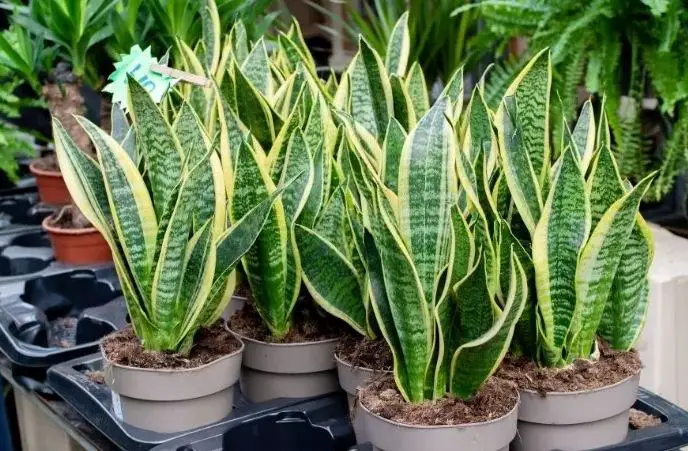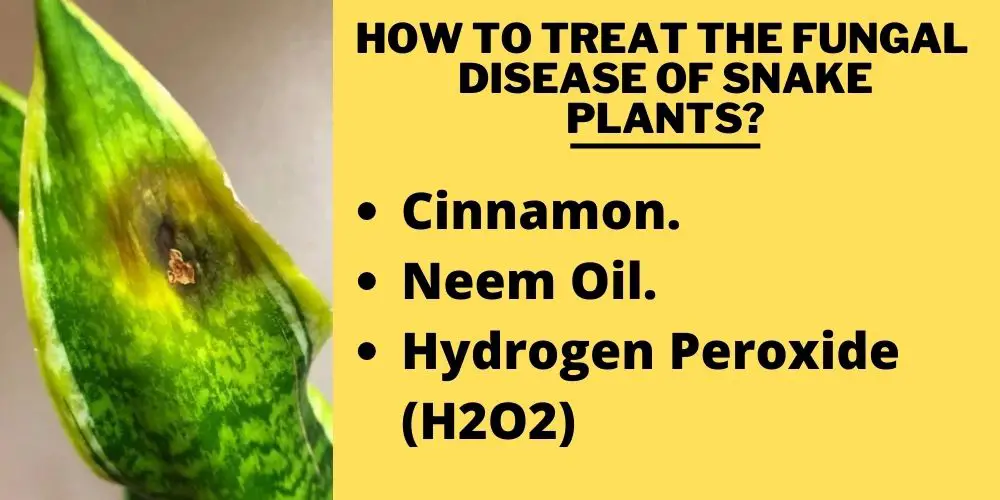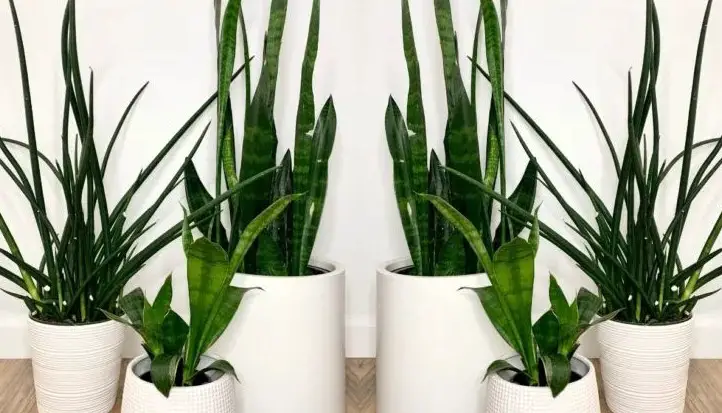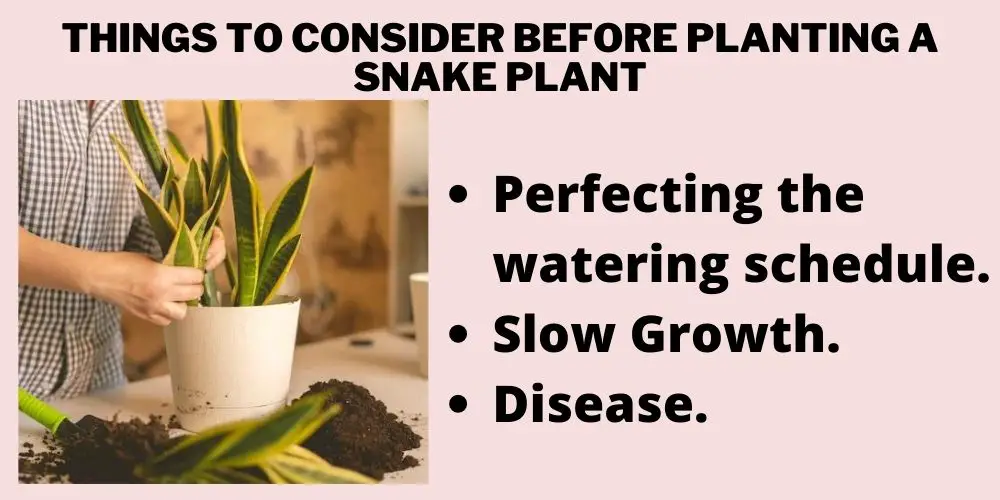Growing plants in pots without drainage holes can quickly lead to their untimely death.
It may seem like your plant’s soil is bone dry at the top, but down at the base could tell a different story. A pot without drainage holes can trap water at the bottom of your pot, even if there are no visible signs above.
Your plant roots may not be able to use this water source fast enough. As a result, the plant could become waterlogged. Once the roots sit in this water for too long, they will suffer from root rot. The plant will die if this issue isn’t corrected as soon as possible.
But, do snake plants need drainage holes as well?
Well, fortunately the snake plants can soak the water up faster, and they can be used with pots that offer minimal to no drainage. So the answer, in short, is No, snake plants do not need drainage holes.
Let’s dive deeper into the topic to learn more, shall we?

Table of Contents
Do snake plants need drainage holes?
Snake plants doesn’t need drainage holes as they are built in a way which helps to soak up the water way faster compared to other similar plants.
The Snake Plant originated in the tropical region of West Africa from Nigeria East over to the Congo. These areas are arid and tough for any plant to survive. On the other hand, the Snake Plant has grown to adapt and even thrive in harsh conditions.
With that being said, to have them as a houseplant, you would be doing something wrong if you managed to kill it with a lack of water. They have an uncanny ability to suck up and utilize an abundance of moisture whilst still being able to grow at the same time.
Therefore, nurturing a snake plant in a pot without drainage is something that even a beginner can accomplish with relative ease.
The key is potting them with a good quality soil and fertilizer. E.g., a well-drained, gritty, sandy soil, such as cactus mix. The nutrients will encourage the growth of a strong root system which will help them keep the pot base from pooling with water. They also thrive with a frequent watering schedule.
Although, they rarely skip a beat, even if you accidentally forget to water them now and then.
How can lack of drainage affect snake plants?
Snake plants don’t necessarily need drainage holes, but they can’t just be planted, flooded, and left for dead. Drainage holes in any pot are always ideal as they offer a way to flush out unwanted matter that may end up stuck in the soil due to clotting.
Some issues can concern any plant, let alone the snake plant, if its pot doesn’t drain well. These problems can come in the form of:

Disease
If you notice that your snake plant’s leaves are turning yellowish, this is a common sign of root rot. Discolouration of any plant should set off alarm bells to help you understand that it needs desperate attention. Dark mushy roots, an off stench, and soil appearance are other tell-tale signs of possible disease creeping in.
As the root system wallows in a pool of water for far too long, it will start to rot and kill the plant. The most common causes are excessive watering, poor drainage and overly moist soil.
Another issue that can form is a fungus, and soaking wet soil is an optimal breeding ground for fungus. Some common fungal diseases are Red Leaf Spot and Southern Blight.
Mineral Deficiency
When a snake plant lacks essential minerals depleted in its soil, such as iron, it can begin to discolor. Mild cases can show lighter/lime green shades along the veins. If left for too long, they can turn more yellow.
This deficiency causes chlorosis. Chlorosis doesn’t necessarily need to take hold of the whole plant, and it can affect smaller parts that are treatable if attended to sooner rather than later.
Lack of Oxygen
The roots of any plant, tree, shrub, etc., need oxygen to grow and ultimately survive! A snake plant is no different. When the soil provided for a snake plant has insufficient drainage, it can cause it to compact and restrict the amount of oxygen the soil can offer, and little or no oxygen can.
How to treat the disease of snake plants caused by lack of drainage?
If you discover that your snake plant is suffering from a disease such as a fungus or a root rot, then have no fear. You have come to the right place as we have some simple tips as well as a guide that you can apply to correct the issue and see your snake plant survive and thrive again.
Luckily, if these issues can be identified early enough, they are treatable. On the other hand, if it is left for too long, it will kill your plant from down at the roots to the top tip! These conditions are usually caused by poor drainage or excessive watering.
Snake plants are pretty hardy but can still succumb to illnesses such as this if not properly managed.
If the entire root system is mushy, unfortunately, the snake plant’s time is up, and there is no other option than to dispose of it. Ensure you sterilize any tools or pots after disposal to prevent any spreading to other plants.
Treatment of root rot
If root rot is the issue, here’s what you can do to breathe life back into your snake plant when it is down for the count.
- Remove plants from pot and soil and rinse root system under lukewarm water. Gently, try to wash away as many of the infected areas as possible.
- Use a sharp, sterilized pair of scissors/shears or a scalpel to carefully prune back where the roots have been affected. Start with any mushy parts that make it hard to get to the rest of the system. Then trim any yellowish, frail and wilted leaves working your way from the outside of the plant towards the center. The older leaves are on the outside. This method will encourage new growth. You may need to wash and sterilize your equipment mid-way if the task is great and the plant has excreted any of its plant goo.
- Dip the roots in a good quality fungicide to reduce the risk of any fungal build-up.
- Replant your snake plant in new, adequately draining soil. Make sure that all pots are thoroughly sterilized before reuse.
Treatment of fungal disease
If your snake plant is suffering from a fungal issue, then the best method to help it heal is by using good-quality fungicides.

Cinnamon
Cinnamon is my go-to for any root rot issues. Not only does it do a really good job, it has a low toxicity rating and is also natural, which reduces the risk of harming anything in the process. Cinnamon is an extremely effective deterrent for cats and dogs who shouldn’t even be around a snake plant due to its mild toxicity.
What I love about it is that it is super simple to use. Just shake some powder onto the roots or branch stumps where diseased leaves have been clipped. You can even add it to the soil. The ingredient cinnamaldehyde in the spice is known to be effective against fungal infections on over 40 different crops.
Neem Oil
Another one of mother nature’s gifts can be extracted from neem fruit kernels. It helps reduce fungi, sooty mold, mildew, etc. It can also help ward off any pests like insects and bacteria. The easiest way to use it is to dilute some in warm water and add it to a spray bottle.
Use:
- 1 teaspoon (5ml) neem oil.
- 1 quart (1 liter) of warm water.
- Half teaspoon of mild liquid soap.
Shake well and spray the plant at the site of the affected area.
Hydrogen Peroxide (H2O2)
Hydrogen peroxide works in the way that, when added to water, the solution breaks down into water and oxygen molecules. When used on a plant, the oxygen provided helps the roots ward off fungi. This keeps the root system growing strong and healthy to sustain and overturn any fight from fungus.
Simply:
- Dilute about 1 teaspoon of good quality 3% H2O2 solution in a cup of lukewarm water.
- Dip the roots and other infected areas into the solution before replanting in fresh soil.
- You can also mix the diluted solution into the soil or add it into your watering by mixing 1 tablespoon of Hydrogen Peroxide with 1 liter of lukewarm water.
How to Grow Snake Plants Without Drainage Hole?
It is possible to successfully grow a snake plant without drainage holes as long as you take a little bit of extra care and know what you’re doing.
What you will need?
- A ceramic pot (at least 18 inches in diameter and 24 inches deep.)
- A polybag that fits the size of your pot.
- Some small pebbles.
- Cocopeat & Perlite mix.
- Snake Plant cutting.
- Spoon or another tool to help with soil and packing.

Potting your Snake Plant
- Sterilize your pot if required. Some pots can carry bacteria and fungus, which cause real damage to newly grown plants.
- Take out your poly bag and lower it into the pot. Make sure that it is pushed down the bottom and to the sides. Stabilize it, so it doesn’t move around.
- Add some small pebbles to around 1 inch of the bottom of the bag/pot. This will act as a last point of drainage. (Although there are no holes in the pot) The pebbles will help aerate the water, so it doesn’t pool and cause rot. It will also allow the roots to move around enough to gain important nutrients.
- Using a spoon, scoop in some coco peat and perlite mix. Fill to around 1 inch below the top of the pot.
- Gauge the size of your snake plant’s roots to see how much of a hole it will need. If they are, for example, 2-3 inches long, then you will need a hole that is the same depth.
- Press your finger or a spoon into the center of the pot to create the planting hole.
- Take your snake plant cutting and gently push it into the center hole. Cover the roots with the coco peat/perlite mix and pad the mix around the roots to hold it steady.
- Add some extra mix to the rest of the way up the pot, filling it almost completely. Again, pad it down to make sure it’s still in place.
- Give it enough water, so the soil is moist but not flooding.
- Check daily to ensure the soil hasn’t clogged up by pushing your finger into it. If your finger comes up dry, you have successfully given it its first water.
- Water every 3-4 days until it establishes itself in its new environment. This should take a few weeks.
- Once the roots have started to strengthen, water every week and a half to 2 weeks. Check the soil periodically to make sure that it has adequate water.
Things to consider before planting a snake plant
Growing a snake plant can be fun as well as rewarding. There are a few things that you should think about before leaping into growing a snake plant, though.

Perfecting the watering schedule
Snake plants have a frustrating talent that absorbs much more water than they require. This makes their watering schedule tough to keep track of. Sometimes it feels like you have given them lots of water, but the soil is dry to the touch.
You may add some more without realizing that the roots are drowning under there, which can lead to root rot and an early end to plant life. Therefore, it’s good practice to only give a small amount of water each time and to keep checking that the water hasn’t pooled lower down.
Slow Growth
Snake plants grow around 1-4 feet tall. The biggest issue with reaching that height is the time it takes to get there. If your snake plant is grown indoors or in a pot that the root system cant spread out in, it will grow considerably slower.
At the same time, an outdoor growing snake plant potted in its right-sized pot can thrive in these optimal conditions. The extra light, sun and rain can boost the plant to grow much faster.
Disease
As we have mentioned earlier in this article, poor drainage can cause much larger issues such as root rot and fungal problems. These diseases can be disastrous for the plant. When a pot can’t drain, the water sits in the bottom where the roots have nothing else to do but to lay in it and rot.
If the diseases can be detected soon enough, they can be fixed. Sometimes it’s as simple as a root clean-up and re-pot. Otherwise, certain natural fungicides can be used when planting to keep fungal problems away. Discoloration and the uncharacteristic appearance of leaves are the main things to look out for.
It isn’t all doom and gloom; snake plants are beautiful and have many promising benefits.
Conclusion
So do snake plants need drainage holes to keep them happy and thriving? No! They can do just fine without holes, as long as some strict guidelines are met. The last thing you want is root rot or fungal issues. This wonder plant is not only aesthetically pleasing but has so many cool pros that will keep you buying more.
They help filter indoor air and remove toxic pollutants. They are effective against most allergies, and to top it all off; they are super easy to maintain. We hope we have helped answer any queries you may have had regarding drainage holes for snake plants.
Thanks for tuning in, and we will see you on the next one.


